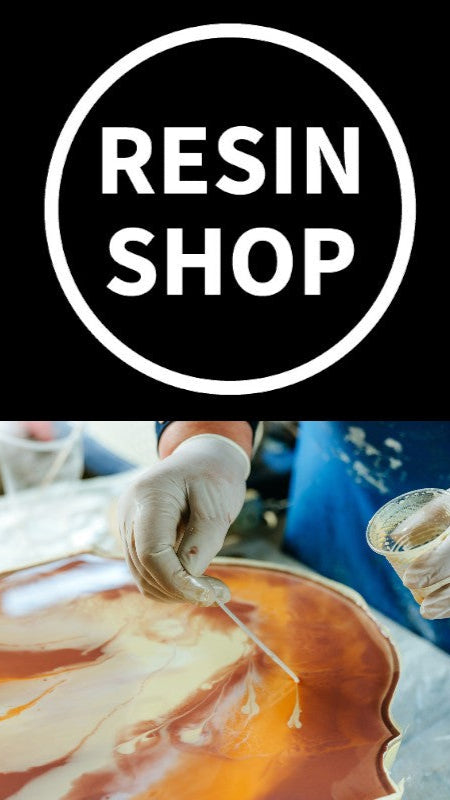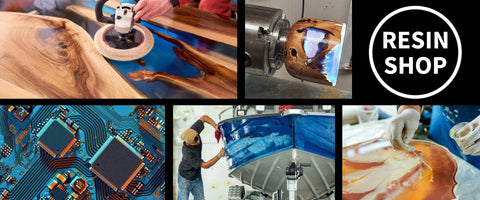FAQs
Last updated
Everything you need to know about Clearpox, EpoxyPro, and StoneFusion — plus pigments, mixing, deep pours & river tables, troubleshooting, safety, industry-specific picks, orders & shipping.
Picking the Right Resin
Which resin should I use for my project?
- Boats & marine laminating/repairs: EpoxyPro EP10 (coating/laminating EP1010; structural EP1020).
- Timber coating, laminating & repair: EpoxyPro EP40 (EP4010 low-visc coatings; EP4020 high-build filler).
- Countertops / benchtops (stone-look veining): StoneFusion Countertop Epoxy.
- General purpose bonding/casting: EpoxyPro EP60.
- Electronics potting/encapsulation: EpoxyPro EP20 series.
- Pool & spa maintenance: EpoxyPro EP70 series.
- Pebble/stone flooring binder: EpoxyPro EP80.
- Concrete floor priming/sealing: EpoxyPro EP8510.
- Penetrating waterproofing/primer: EpoxyPro EP30.
- Ultra-clear art, casting, river tables: Clearpox Ultra Clear.
Do you offer sample kits?
Yes — sample sizes are available (handy for testing colour, clarity, adhesion and cure before scaling).
Mixing & Use
What is the mixing ratio for your epoxy resins?
Clearpox, StoneFusion and EpoxyPro use a 2:1 (resin:hardener) mix by volume. The Deep Pour system uses 3:1. Measure accurately and mix thoroughly, scraping sides and base of the cup.
How much resin do I need (coverage guide)?
Rule of thumb: 1 L covers ~1 m² at 1 mm (≈1000 cm³). Multiply area by thickness for volume, then add waste margin. Use the Resin Volume Calculator for exact pours.
What temperature should I pour at?
Ideal workspace is ~25 °C. Keep pours at ≥18 °C. Below ~15 °C cure slows and finish can suffer. You can gently warm bottles (~30 °C water bath) and condition the room.
How thick can I pour in one go?
Shallow seal coats: 0.5–2 mm; flood coats: ~2–4 mm. For deep castings, use the Deep Pour formulation or layer to manage exotherm/clarity. Test on a small mould first.
Can I add pigments, metallics or alcohol inks?
Yes — use epoxy-compatible pigments/pearls or alcohol inks. Add sparingly (often <5% by volume; for deep pours, stay far lower). Always test for the look and cure you want.
Deep Pour & River Tables
Clearpox Ultra Clear vs Deep Pour — what’s the difference?
Clearpox Ultra Clear (standard): 2:1 mix, medium viscosity, quicker set in thin films — seal coats, flood coats, topcoats, small casts.
Deep Pour: 3:1 mix, very low viscosity, long pot life — thicker clear castings with reduced exotherm and excellent bubble release.
Is the Deep Pour 3:1 “self-levelling” like the 2:1?
Yes. Both self-level on a prepared, level surface. 2:1 is favoured for coatings/flood coats; 3:1 is optimised for deep casting where heat control and clarity are key.
What’s the typical working time?
It depends on mass and temperature. As a guide at ~25 °C: 2:1 ≈ ~1 hour in small mixes; 3:1 ≈ several hours. Always test in your conditions.
Can I use Deep Pour to seal live edges?
You can, but a thin 2:1 seal coat usually sets faster in thin films. If using 3:1, apply a very thin coat and pour the main layer when tacky.
How do I maximise bond between layers?
Pour the next layer in the product’s tacky/gel recoat window for chemical bond. If you miss it, lightly abrade (180–220 grit), clean, then pour.
Troubleshooting
How do I minimise bubbles?
- Warm parts to ~25 °C; mix slowly; use a wide, flat stirrer.
- Seal porous timber with a thin seal coat before flood coats.
- De-gas with brief, careful heat-gun passes (don’t scorch).
Why is my surface hazy, sticky or soft?
Common causes: off-ratio mixing, poor scraping during mix, cold environment, moisture contamination. Re-coat only after full cure on a clean, keyed surface; remove uncured patches and re-cast if necessary.
Will the resin yellow in sunlight?
All epoxies slowly yellow with UV. For long-term clarity, use Clearpox indoors and consider a UV-stable topcoat for high-UV environments. Limit prolonged direct sun on clear finishes.
Is it food safe when cured?
Clearpox and StoneFusion cure to a non-toxic, VOC-free, inert plastic — suitable for incidental food contact (boards, benchtops). Allow full cure (often 7+ days). EpoxyPro trade/industrial systems are not assessed for food contact.
Pigments & Additives
How much pigment should I use by volume?
Short answer: start small and keep total non-reactive additives under about 5% of mixed epoxy (and far less for deep pours).
-
Transparent tint: ~0.1–0.5% of mixed epoxy
Rule of thumb: ~1–5 drops per 100 mL. -
Pearlescent powders (e.g., Jacquard Pearl Ex): ~0.5–3%
Rule of thumb: ≈ ⅛–¾ tsp per 100 mL (½–3¾ tsp per 500 mL). -
Solid/opaque with powders: ~2–5%
Rule of thumb: ≈ ½–1½ tsp per 100 mL (2½–7½ tsp per 500 mL). - Deep pours: stay at the low end (≈ ≤1–2%) to control heat/clarity; heavy powders can settle — add swirls near gel if desired.
| Use case | % of mixed epoxy | Guide / 100 mL | Guide / 500 mL |
|---|---|---|---|
| Transparent tint | 0.1–0.5% | ≈ 1–5 drops | ≈ 5–25 drops |
| Pearlescent powder (e.g., Jacquard Pearl Ex) | 0.5–3% | ⅛–¾ tsp | ½–3¾ tsp |
| Solid/opaque with powder | 2–5% | ½–1½ tsp | 2½–7½ tsp |
| Deep pours (limit load) | ≤1–2% | ⅛–½ tsp | ½–2½ tsp |
Guides only — always test first. Mix resin + hardener fully, then add colour. Pre-wet powders in a small amount of mixed epoxy to avoid clumps; scrape sides and base while mixing. Wear a P2/N95 mask when handling fine powders.
How much alcohol ink can I add to epoxy?
Alcohol inks are strong dye concentrates in solvent. Too much can soften the surface or slow cure. Keep totals small:
-
Veins/marbles & transparent effects: ~0.1–0.5% of mixed epoxy
Rule of thumb: ~1–3 drops per 30 mL, or ~3–10 drops per 100 mL. - Absolute max: about ≤1% of mixed volume (including any isopropyl alcohol used for effects). If the piece stays tacky or rubbery, you’ve likely over-added.
Tips: Let solvent flash briefly before covering; use gentle heat sparingly to avoid pinholes; for items used around food, keep inks/pigments to decorative areas only and allow a full cure.
What pigments work best for countertops and river tables?
For stone effects, pair StoneFusion with metallic pearls and a touch of alcohol ink for veining/marble lines. For river tables, Clearpox with mica pearls gives depth without clouding.
Can I tint structural and composite systems (e.g., EP55/EP10/EP20)?
Yes — most systems can be tinted modestly without compromising cure. For composites (e.g., carbon fibre) use compatible tints and keep loading low to preserve mechanical properties and wet-out.
Safety & Compliance
What PPE and safety steps do you recommend?
- Nitrile gloves, eye protection, covered skin; good ventilation.
- Read the product’s SDS/TDS before use. Dispose of cured waste responsibly; never pour resin/solvents down drains.
- Know basic first aid: wash skin with soap/water; flush eyes and seek medical advice if exposed.
Do you supply SDS/TDS for all products?
Yes — SDS/TDS and specs are available on request for trade and retail orders. Provide the product name and kit size so we can send the correct documents.
Orders & Shipping
How do you ship resin kits and bulk orders?
We use national couriers for parcels and road freight for larger consignments/pallets. Tracking updates activate once the carrier collects your order. For bulk drums or multiple 15–30 L kits, request a tailored freight quote.
Can I track my order?
Yes — tracking is emailed once your parcel is booked with the carrier. If you don’t see it, check spam or contact us with your order number.
Storage & Shelf Life
How should I store resin and hardener?
- Keep sealed in a cool, dry place (ideally 15–25 °C), out of direct sunlight.
- If resin thickens in cold weather, warm the sealed bottle in ~30 °C water before use.
- Wipe threads after pouring; keep moisture out of containers.
What is the shelf life?
Unopened: typically 12–24 months when stored correctly. After opening: best within 6–12 months. Always check product label and batch details.
Quick Picks by Industry
- Marine: EpoxyPro EP10
- Timber & furniture: EpoxyPro EP40
- Electronics: EpoxyPro EP20
- General trades: EpoxyPro EP60
- Pool & spa: EpoxyPro EP70
- Pebble flooring: EpoxyPro EP80
- Concrete priming: EpoxyPro EP8510
- Penetrating sealer: EpoxyPro EP30
- Countertops: StoneFusion
- Art/casting: Clearpox Ultra Clear
Search Our Resin Knowledge Base
Not sure which resin is right? Try Find My Resin or search guides, FAQs and product picks.
Can’t find it? Submit Your Query and our team will reply and add useful answers to the FAQs.
General advice only: Always follow the product label and SDS/TDS. Test small before full projects, especially for deep casts or critical applications.
Project-specific advice policy: We’re happy to share general guidance from our pages, but we can’t engineer project-specific specifications or guarantee outcomes for unique builds. For deep pours and pigmented castings, please run a small test pour in your workshop conditions first. If your project needs detailed, project-specific advice, we recommend working with a local fabricator or epoxy specialist.


